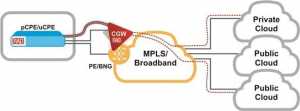Network virtualization, full network cloudification and hyper-connectivity are the key global trends that address the increasing demand for dynamic application delivery with ever-growing data consumption. They are also meant to enable optimal user experience with new capabilities and seamless service, in line with enterprises’ digital transformation. By 2023, 50% of enterprise network services are estimated to be delivered using cloud technology, from SMEs and enterprises that are gradually migrating their workloads from on-prem data centers to public clouds, to “Born in the Cloud” organizations, which rely on SaaS from day one.
Emerging services and applications, such as IoT, autonomous systems, device/cloud applications, and more pose special requirements in terms of performance, latency, resiliency, and local storage. To address these requirements, communications service providers (CSPs) are extending compute services and storage closer to end-users, allowing among others, to avoid transmitting large amounts of data to remote data centers (DCs) that are located deeper in the network. Over the past two years, many CSPs have been deploying regional DCs at distances that allow only a few milliseconds of transmission delay. This enables them to use lower-cost, thin customer premise equipment (CPEs) at the end customer branches and open a secure tunnel from them to the specific application workload running on the regional DC.
Another aspect of note is the competitive landscape of CSPs’ business and enterprise IP-VPN services. These are increasingly being threatened by over the top (OTT) offerings such as SD-WAN, for which telcos are typically providing mere connectivity without much-added value. Their challenge, in this case, is to move up the value chain, preferably by using their own network and cloud infrastructure assets to offer better alignment with their customers’ needs.
The New Arm-powered vCPE Edge
RAD’s vCPE edge portfolio showcases a range of solutions to meet the diverse requirements of businesses throughout their digitalization and cloud adoption journeys. It is designed to help service providers leverage their “real estate” – that is, the network edge and CSP data center – and introduce value-added services (VAS) beyond simple connectivity.
RAD’s vCPE architecture follows three main principals:
- Disaggregation: Freedom to use any hardware and virtual functions of choice, with the same common operating system
- Automation: All vCPE solutions are managed by a single Domain Orchestrator for consistent operations of business services and edge devices, across all sites.
- Virtualization:vCPE functionality is shaped by the introduction of hosted virtual functions by any vendor, either as VMs or containers.
RAD offers two CPE flavours built on an Arm core that cater to the requirements of business sites, large or small, as well as for outdoor locations with special environmental requirements. These CPEs are based on Arm Cortex-A53 64bit dual-core, delivering superior performance with extremely low power consumption for better cost savings. They implement a variety of services that can be flexibly uploaded and tailored as containers.
The ETX-1p is a thin CPE – economical, disaggregated and optimized for cloud access services with resilient, multi-link connectivity over VPNs, as well as over fixed or mobile broadband networks. It serves as the CSP’s demarcation point at branch offices and enables the delivery of cloud-based and value-added, virtualized services. The ETX-1p combines powerful networking and security capabilities and can host third-party, container-based applications. As an edge infrastructure, the ETX-1p allows CSPs to define secure tunnels from the end customer’s premises and run latency-sensitive applications wherever they need them in a fast, efficient, and economical manner. In addition to the ability to integrate with CSPs’ SDN controllers, it is designed to be efficiently automated and orchestrated to minimize the effort associated with mass deployments, as well as to reduce operational costs.
The SecFlow-1p is a CPE designed to address business sites with harsh environmental conditions, including extreme temperatures and dust. It supports all of the ETX-1p’s capabilities and is packaged in a ruggedized enclosure. In addition, it offers multiprotocol wireless connectivity, such as LoRa, LTE and more. The SecFlow-1p serves as an IoT gateway, connecting with a multitude of sensors and smart IoT devices to meet the needs of a rapidly growing market in various critical infrastructure segments, such as smart/safe cities, utility companies and Industry 4.0.
Both the ETX-1p and SecFlow-1p run the vCPE-OS, a lightweight open operating system that serves as the virtualization infrastructure with embedded routing and firewall functionalities. The RADview Domain Orchestrator provides consistent operations across all sites and edge device types. It offers full life cycle support (such as zero-touch provisioning, software updates and maintenance), SDN/NETCONF support and automatic set up of network tunnels.
A Range of Business Connectivity Services
RAD’s Arm-powered vCPE edge portfolio supports a variety of business networking services ranging from VPN to cloud access offerings. Different businesses and even different sites are free to choose their preferred connectivity option based on their current requirements and scale it later in time as their needs evolve. Various sites of the same organization may deploy different business edge vCPE options and have them stitched together into a single business VPN.
Typical supported services include the following:
Managed Business Router / Customer Edge Replacement
A disaggregated vCPE router is an ideal up-to-date replacement option for legacy business routers that are due to be replaced. This option includes a managed business router that provides MPLS VPN access and can be used to host multiple functions that otherwise may have been implemented using several boxes. The disaggregated vCPE allows the service provider to avoid vendor lock-in, as well as to host best-of-bread functions from any vendor and use off-the-shelf hardware.
 Customer Edge Router Replacement
Customer Edge Router Replacement
Overlay VPN over Fixed/Mobile Broadband Network
With VPN over broadband, business sites are not bound to MPLS access links and can instead connect to the organization’s VPN over lower-cost fixed or mobile broadband access links, either as the primary link or as the backup to the MPLS ones. This allows the CSP to expand its L3 VPN services to unserved sites, as well as offer its enterprise customers the ability to connect pop-up business sites to the corporate VPN. Such connectivity services use a secure overlay either over the service provider’s own broadband access links or over third-party provider networks.
Overlay VPN over Fixed/Mobile Broadband Access
SD-CloudAccess
For “Cloud-first” enterprises or business customers that are transforming to the cloud, RAD offers SD-CloudAccess. By introducing application-aware traffic steering across multiple links, this solution enables businesses to benefit from SLA guarantees for their cloud access services.
SD-CloudAccess uses a single set of overlay tunnels that are terminated at a virtual cloud gateway, typically deployed at the service provider’s edge. By landing all traffic at their network’s edge, service providers can use their own footprint to host value-added cloud and cloud on-ramp services, such as hosted SASE.
SD-CloudAccess
Market Reception and Collaborations
We at RAD believe that Arm’s architecture provides significant cost benefits and enables us to offer open solutions to a wide array of use cases in a variety of verticals at highly attractive price points. CSPs’ reaction to the thin CPE use cases reflects this and has been very positive. Furthermore, we are currently in the process of certifying various software vendors that support different types of containers. These containers can run on RAD’s Arm-powered CPEs to provide additional value to our customers.
RAD’s cooperation with Arm and participation in its growing ecosystem simplifies scale-up, as it eliminates the complexities associated with pre-integrated subsystems. Customers and partners can quickly design and deploy their desired solutions with greater flexibility and efficiency.










